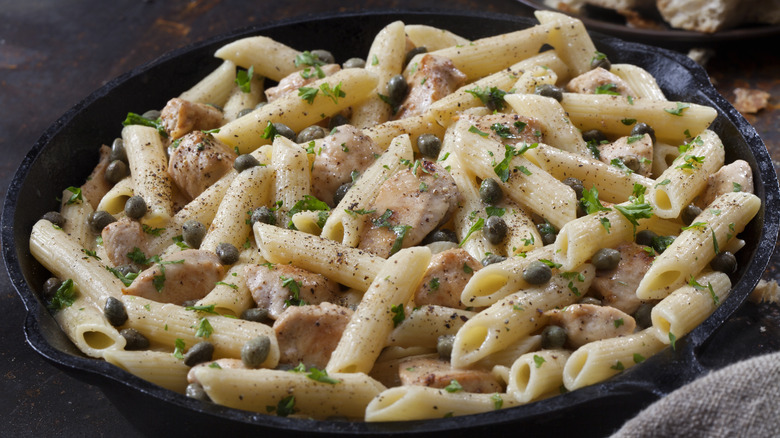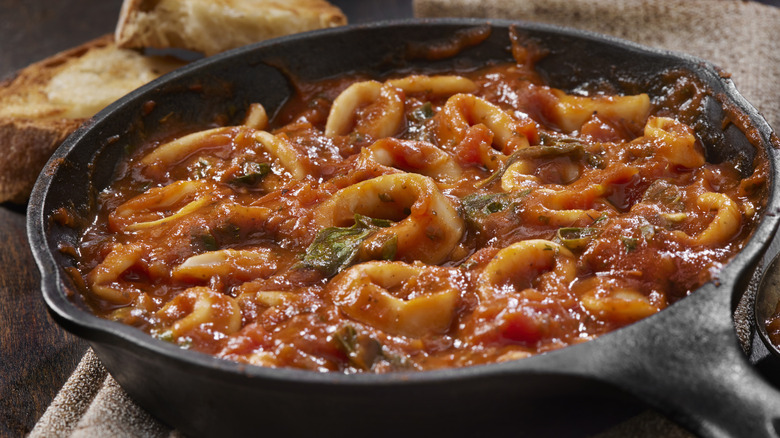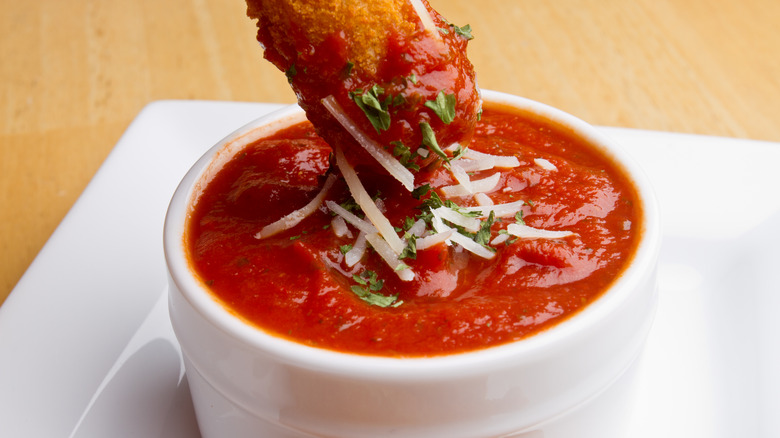Marinara Vs Alfredo Sauce: Everything You Need To Know
The idea of a sauce war may not have occurred to most people, but when the chips are down and a choice is forced, the decision between marinara and Alfredo is usually pretty clear. How could these two recipes be compared? There's no real overlap among ingredients or preparation methods, and marinara has been on Italian tables for over 500 years, while Alfredo is a 20th-century invention. The only aspects marinara and Alfredo have in common is that they're both Italian and used to dress pasta dishes. Other than that, each tends to stay in its culinary lane.
Considering both sauces are popular choices that inspire loyalty from their respective fans, we thought a breakdown of what makes each one special was in order. Beyond the obvious differences, there are some significant distinctions that put each recipe in a class of its own. You'll find some savory and surprising facts among the meatier bits of the sauce talk. Whether the information inspires you to take your own homemade sauces for a test spin or merely lends insight for ordering at your favorite restaurants, here's the story that is sure to stir the pot.
Their origin stories
Both sauces have equally rich histories, but each comes with its own distinctive origin story. Marinara was developed as a sauce in Naples in the 16th century after the Spaniards delivered the first tomatoes to Italy. Marinara, the Italian word for sailor, arose either because the sauce was a dish given to returning sailors or due to the fact that it kept well during long ocean voyages. Whichever is true, the earliest references to marinara appear in a cookbook from 1692, and it eventually became the quintessential Italian pasta sauce.
As for Alfredo, a recipe from the 15th century makes reference to Roman pasta made with cheese and butter, which is perhaps the earliest mention of a creamy sauce. In 1914, Alfredo di Lelio created the first true Alfredo sauce by pairing handmade fettuccine with butter and Parmesan to nourish his wife after she gave birth to their son. Eventually, Hollywood luminaries Douglas Fairbanks and Mary Pickford traveled to Rome in 1920 and sampled the dish, ultimately leading to it becoming a modern sensation.
Regional distinctions
Though American culture tends to label any red tomato sauce as marinara, there's a specific regional element to authentic Neapolitan marinara. Fresh tomatoes are essential to the recipe, which requires a proper simmer and careful attention to timing. In contrast, jarred sauces can't capture its truest essence, because the magic arises in the process. The expectation of what a real marinara tastes like in Naples versus a similar sauce in America might surprise Italians and Americans, both of whom are accustomed to their own versions.
Alfredo became part of the Italian culinary heritage in Rome, after Alfredo di Lelio brought his invention to his restaurant, conveniently called Alfredo's. But where marinara is a staple of Italian kitchens everywhere, true Italians find the sauce Americans call Alfredo a little hard to digest, at least where the name is concerned. The recipe for Roman Alfredo uses only butter and cheese, making it simpler than the American Alfredo version which includes garlic and cream. The Roman style is also prepared with a more delicate touch and sometimes mixed at the table by waiters who double as pasta artisans.
Main ingredients
The main ingredients in marinara are tomatoes, tomatoes, and more tomatoes. Crushed or fresh tomatoes are fair game, depending on the complexity of the recipe you're using. You'll also use roasted garlic, onions, olive oil, and fresh herbs to round out the mix. Salt and pepper are a must, of course. Depending on what your palate determines your sauce needs, you can also add a bit of sugar for sweetness, vinegar for acidity, or grated Parmesan to ramp up the richness. Anything that goes into the pot beyond this is strictly a matter of your culinary invention.
The main ingredients used in Alfredo sauce recipes couldn't be more different. Butter and heavy cream form the base, with Parmesan and Romano cheeses added for texture and flavor. Garlic provides the zesty flavor that melds with the heavier elements, providing tangy top notes that cooperate rather than compete. Flour is included in the blend as well, to thicken the sauce without compromising its pale complexion. Black or red pepper can be added to taste, lending a more sophisticated layer to keep the dairy ingredients from overwhelming the palate entirely.
Flavor profiles
Marinara may be the most familiar of the Italian sauces. Its bright flavor carries the tang of a thousand tomatoes, though the recipe calls for far fewer. Aromatic elements like onions and garlic add to the fragrance, deepening the relatively uniform tomato flavor. You'll also taste oregano, thyme, and sometimes basil, all familiar herbs that round out the body of a proper marinara. For cooks hoping to improve the taste of jarred marinara, try tossing in fresh herbs to ramp up what's already in the recipe but might need a little extra emphasis.
In its purest form, Alfredo is butter, cream, and cheese, all of which provide a luscious, rich flavor and creamy texture. Rather than having the essence of fresh herbs found in marinara, Alfredo has elements of garlic, usually in powder form, and black pepper, as well as the occasional red pepper flake to dial up the heat just a touch. Adding extra pepper or Parmesan to Alfredo can lead it in a more gourmet direction. This is an easy way to improve a store-bought sauce too.
Mistakes you might make when making your own
Your best bet for making magnificent marinara (while avoiding the common mistakes people make when making the sauce) is to keep it simple. There's no shame in using canned crushed tomatoes, especially since using the wrong type of fresh tomatoes picked out of season can do more harm than good. Cooking marinara should be a lengthy process, rather than a quick spin through the kitchen, to ensure the flavors come together and the texture takes hold. And though you might have seen other cooks blitz their marinara in a blender to make it ultra-smooth, leaving it chunky is a better way to go.
For Alfredo sauces, the most common mistake is cooking with too much heat. This tendency to overheat leads to what chefs call a broken sauce, which means the fats separate from the starches. A slow increase in heat will allow the emulsification process enough freedom to bring the fats and starches together properly, resulting in the silky Alfredo you know and love. It's also important to add the butter slowly to allow smaller fat particles to combine with the starch. Because Alfredo is a cream sauce and therefore a touchy creation, caution is key.
Best storebought options
The pasta sauce section of the grocery store offers a wide range of jarred marinara. The clear winner in the ranking of worst to first options is Rao's, a product recommended by none other than the Barefoot Contessa herself, Ina Garten. Other top-shelf options include Lidia's marinara sauce from celebrity chef Lidia Bastianich and Newman's Own organic marinara. Sauces that sank to the bottom of our list were canned versions from better-known national brand names like Del Monte and Hunt's. These lesser products may be more affordable and can still be doctored up to augment the flavor, depending on your taste.
When it comes to Alfredo sauce, the best of the batch comes from Giovanni Rana. It requires refrigeration rather than sitting on dry food shelves because it has no stabilizers or hydrogenated fats, as well as a refreshing absence of artificial flavors and colors. Newman's Own also manufactures a winner in the Alfredo field, as does Rao's. If price is a top consideration, you can explore Alfredo options from Ragú and Prego to find a prepared option that fits the occasion, as well as your food budget.
Nutrition facts
The generous use of tomatoes in marinara means this sauce is filled with a healthy phytonutrient called lycopene. This chemical gives the fruit its bright red color and is an antioxidant that may help reduce the risk of cancer, as well as increase bone density (via Verywell Health). As for the basics, My Fitness Pal lists a half-cup serving of marinara as containing 80 calories, 4.5 grams of fat, and 2 grams of protein. The carb content consists of both sugar and fiber, and there's also 70% of the daily recommended value of vitamin C in the mix.
On the other end of the spectrum, Alfredo makes a decidedly different nutritional impression. Nutritionix lists a half-cup serving as containing a staggering 538 calories, 51 grams of fat, and 14 grams of protein. There are negligible quantities of vitamins in the sauce, and the majority of the fat content falls under the saturated heading. Alfredo is clearly a decadent sauce that should be used sparingly by health-conscious eaters.
Which pasta dishes go best with each?
Marinara is something of culinary chameleon, blending in perfectly with pasta dishes of all types. The highly concentrated flavor of slow-cooked marinara sauces pairs better with tube-shaped pastas served loose or in bakes, allowing the thick liquid to achieve maximum coverage inside and out. Just about any type of meat will play nicely with marinara — everything from ground beef to filets to pork. And if you've ever had chicken Parmesan with pasta, you know how well poultry matches up with the tangy flavor of marinara. Garden vegetables, including fresh or cooked tomatoes, can be topped with marinara for tasty vegan or vegetarian options for plant-forward eaters.
Cream-based Alfredo has a more specific list of guests to invite to the table. Naturally, this sauce has an affinity for fettuccine. But Alfredo also works effectively with other broad-shaped pasta, like tagliatelle. Lighter meats and fish like chicken and shrimp are a natural match, as are green vegetables like peas, broccoli, and spinach. You can even incorporate spinach into the sauce itself to add layers of taste and texture — not to mention, vitamins.
Other uses
Marinara moves quickly from the center of a traditional Italian table to find itself in all sorts of flavorful spots. You can use this zesty red spread on pizzas or meatball subs, adding a dash of heritage to these hearty favorites. Create calzones filled with cheese, meat, and veggies with a robust marinara blast. Or pour the sauce into a ramekin and serve it with fried mozzarella sticks and ravioli for a beloved bar-bite selection. Marinara also doubles as a dip for bread, as an alternative to olive oil and herbs, and perfectly dresses up cooked or raw broccoli and cauliflower.
With Alfredo in your kitchen, you have a luxurious sauce that can turn dinner time into an elegant affair. White pizza with Alfredo sauce makes a gourmet departure from your usual pie. You can even add it to soups to lend a creamy element, as well as in lasagna to take a familiar recipe into new territory. Alfredo also makes a great addition to dip platters and can sit shoulder-to-shoulder with marinara as an inspired party pair-up that gives your guests options. Use breadsticks, herbed toasts, and crudités as sturdy dipping fare for your sauces.
How long does each last in the fridge?
While jarred marinara may often contain preservatives, it won't last forever in the fridge. In an interview with Southern Living, executive director of Partnership for Food Safety Education Britanny Saunier explains that leftover sauce should be frozen or used within four days of being opened. She also advises that unopened jars should be checked periodically and disposed of if older than 18 months. If you've taken pains to make more than you can use in a single sitting, freezing the extra should be part of the plan.
Food facts website Does It Go Bad? provides similar information about Alfredo sauce, providing a guideline of three to four days for both jarred and fresh versions. Alfredo also has dairy ingredients that may necessitate a shorter shelf life for unopened jars. Using the expiration dates printed on the label or jar lid is the safest way to decide whether you should use your Alfredo, or throw it away and purchase a new jar. As with all food safety, if there's any question about the freshness of your Alfredo sauce, it's best to err on the side of caution.
How do you successfully reheat each?
Properly reheating marinara sauce is one of the most important kitchen techniques you can learn, especially if you're making your own. You'll extend the use of your sauce and have a handy supply of pasta topping and dipping sauce whenever your dish calls for it. To reheat your marinara, pour it into a pot and heat it on the stovetop over medium heat. Bring the liquid to a boil, giving it a few stirs along the way. Then, turn the heat down to a low setting and let the sauce simmer for about 10 minutes, leaving the lid off and stirring occasionally.
Reheating Alfredo sauce is a bit touchier, as the butter has a tendency to separate and ruin the texture. The stovetop method begins by adding a tablespoon of butter to Alfredo in a saucepan, heating it over medium, and stirring with a wooden spoon the whole time. You can add milk or water to thin out a thicker sauce, and for a little extra flavor, refresh it with pepper and Parmesan. You'll have a smooth resurrection of your Alfredo sauce to dress new dishes.
What happens when you mix the two together?
Alfredo and marinara have more of a cooperative relationship than their drastic differences might suggest. Blending the two in a single recipe will result in a sauce that can be referred to as rose, rosé, or rosa, depending on whose kitchen you're cooking in. A rose sauce is a quick recipe to create, with ingredients from the two sauces occupying a single pot. An even easier way to enjoy this heavenly hybrid is to open a jar of each and blend them together. Remember to freeze the leftovers, either individually or mixed, so you can savor your rose pasta sauce in future meals.
This tricky twist might sound similar to vodka sauce, which uses a tomato base with cream with a little clear spirit dropped in to elevate the zing. Whatever you choose to call it, eliminate the struggle of choosing between marinara and Alfredo sauces, and give both an equal shake. Whether you serve them up separately or swirl them together, a table that offers a variety of sauces will leave everyone satisfied.












